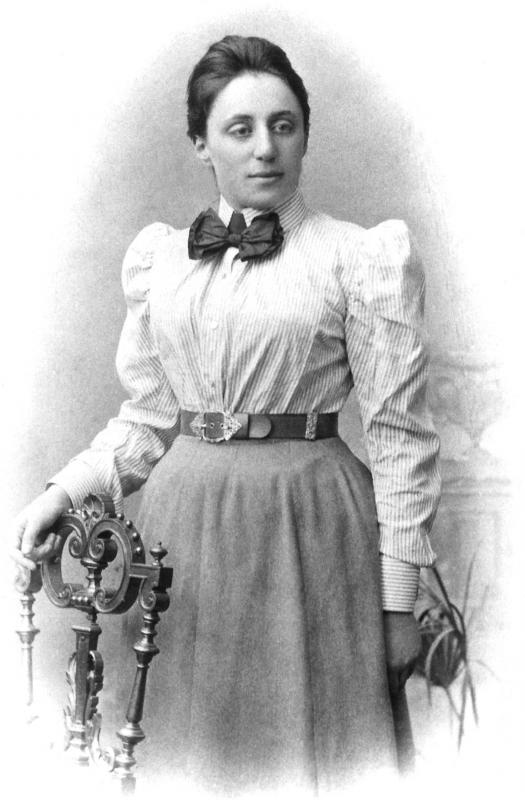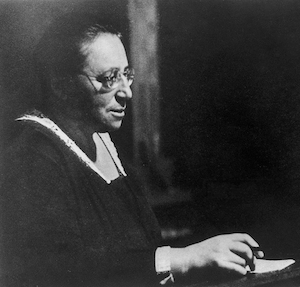Emmy Noether
This article has been adapted from an article published on Plus, NRICH's sister project.
Emmy Noether lived from 1882 to 1935. In a letter to the New York Times in 1935, just after she died, Albert Einstein wrote:
"Fräulein Noether was the most significant creative mathematical genius thus far produced since the higher education of women began."
And he wasn't the only one to praise her — in fact, many people think she was one of the greatest mathematicians of her time.

But what did Einstein mean by "creative mathematical genius"? Emmy mainly worked on algebra, which is about writing symbols for mathematical objects, such as numbers. Algebra is a useful tool to describe the relationships between such objects. The relationships contain patterns and structures that a good mathematician can sense, just as a musician can feel the rhythms and structures in a piece of music. And just as a musician has to stick to certain rules when writing a new piece of music (otherwise it'll sound awful) so a mathematician is guided by the rules of logic when discovering new equations and relationships. In fact, Albert Einstein called pure mathematics the "poetry of logical ideas".
Linking algebra to physics
Emmy’s deep understanding of algebra led to a result that is actually important in physics. As you will learn in physics as you get older, some things always stay the same. An example is energy: energy can't be created out of nothing, and it can't just disappear. When you kick a football, the energy of your foot doesn't disappear after the kick, instead it's transferred to the ball, so the overall amount of energy remains the same. We say that "energy is conserved". Another conserved quantity is momentum, which is related to the speed and mass of an object (loosely speaking it measures how hard it would be to stop that object in its tracks). When you kick the ball, your foot might lose its momentum after the kick, but the momentum hasn't disappeared: it's been turned into the momentum of the ball, and the overall amount of momentum remains the same.
With great insight, Emmy figured out how these conservation laws are reflected within the mathematical equations that describe the physics. Conservation of momentum, for example, is linked to the fact that the equations look the same no matter where you are in space — you use the same equations whether you are in London, New York or on the Moon. Conservation of energy is linked to the fact that the equations look the same no matter where you are in time — whether you apply them today, tomorrow, or in ten years' time.

When an object remains unchanged even though you are doing something to it, mathematicians say that the object is symmetric. A picture of a butterfly has a mirror symmetry, for example, because you can reflect it in a line down its centre without changing its appearance. The equations we just talked about remain unchanged when you "move them around" in time and space, so they are also symmetric in that sense. Therefore, Emmy’s result links the conservation laws of physics with a concept that at might at first appear to have nothing to do with them: symmetry.
Against the odds
Why did Albert Einstein mention the education of women in his praise for Emmy Noether? Because Noether had to fight every step of the way to be allowed to follow her passion for mathematics. When she decided to enter university in 1900, women were still not allowed to get university degrees. They were allowed to sit in on lectures (like being in class), but only if they had the permission of the professor. As Emmy’s father, Max Noether, was a mathematician at the University of Erlangen, the professors were family friends, and so Emmy was able to gain their consent.

In 1904, after four years of unofficial study, the rules were relaxed and Emmy was finally allowed to enroll at university. She went on to complete an excellent degree in 1907, which earned her a PhD. But at the time women were not allowed to get jobs at universities, so Emmy spent years working without pay and without an official job. Several famous mathematicians and scientists supported Emmy (including Albert Einstein), but it was not until the 1920s that she was given a paid job at the University of Göttingen. The salary was tiny, however, and she could barely survive on it.
When the Nazis came to power in the 1930s Emmy was one of the first six professors fired from Göttingen because she was Jewish and she did not share the Nazi party’s political views. Emmy’s friends started a frantic search to find her a university job abroad. Eventually, she was granted a temporary one-year position on a modest salary at a small women's college, Bryn Mawr, in the United States. By 1935 enough funds were scraped together to support Emmy at a reduced salary for another two years.
Sadly, Emmy Noether died relatively young. In 1935 she went into hospital to have an operation to remove a large tumour. For a few days it appeared as though the surgery had been successful but then she suddenly died. She was in her early fifties at the height of her creativity and powers. But her legacy lives on — she is still considered one of the best mathematicians of all time.
